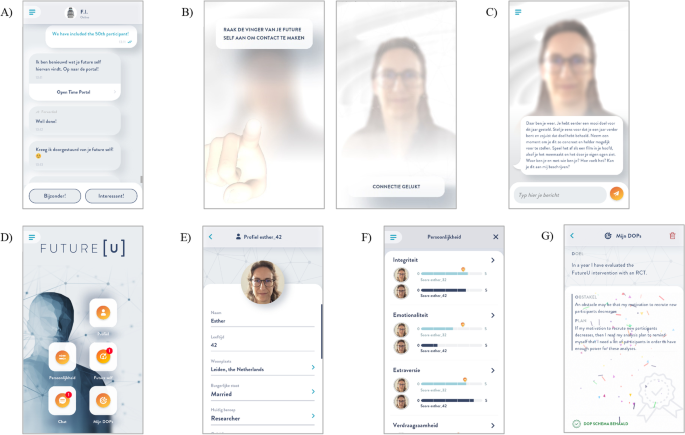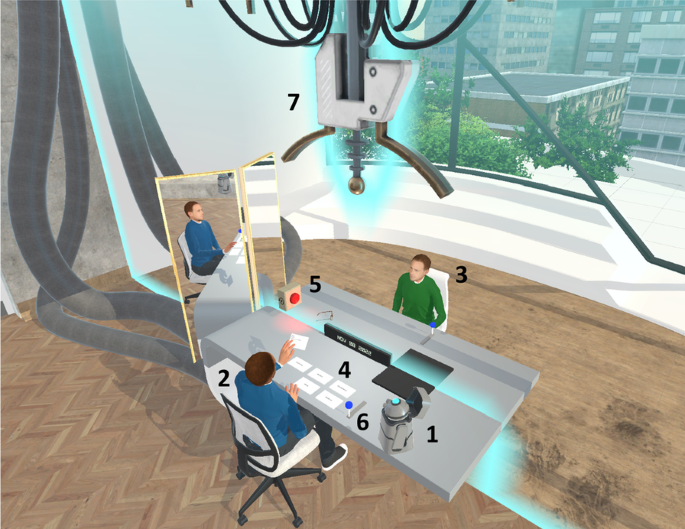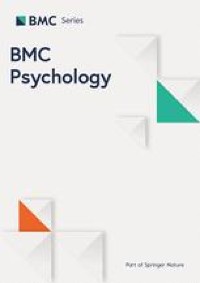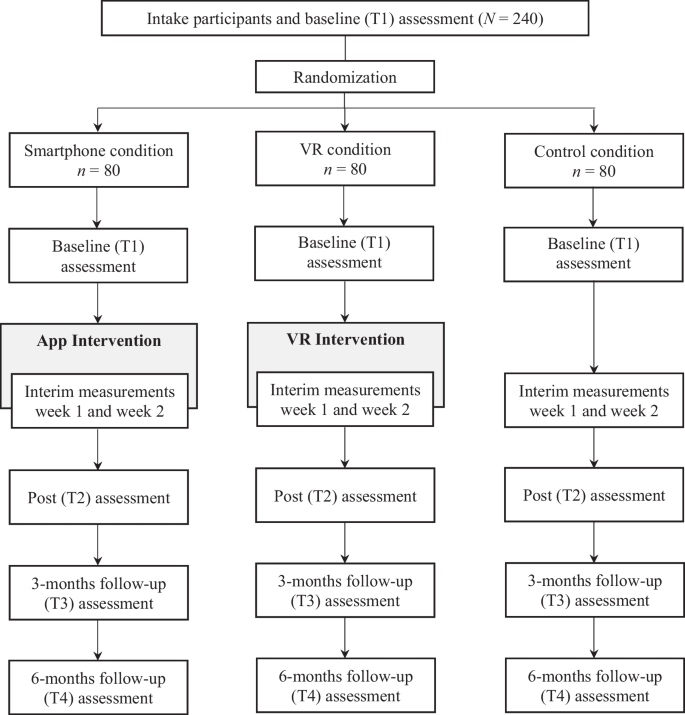Design
The current study regards an iteration and extension of a prior pilot RCT [see 31] evaluating the first version of the FutureU app. In the present study, the intervention will be examined through an RCT with three conditions: (1) a smartphone condition in which the intervention is implemented via (an iteration of) the FutureU app, (2) a VR condition in which the intervention is delivered through immersive VR, and (3) an active control condition in which participants set goals but receive no further intervention. Ethical approval was obtained from the independent Ethics Board of the Institute of Education and Child Studies at Leiden University (ECPW2021-320). The trial was registered on Clinicaltrials.gov (NCT05578755) on 13 October 2022.
In all conditions, participants start with an intake session. During this session participants give active informed consent, set personal goals, and complete an online questionnaire. In both intervention conditions, an avatar will be created and aged using a machine learning-based algorithm to generate a digital version representing their 10-year older, and hence ‘future’, self (see ‘Avatar Creation’ below).
All participants complete online questionnaires at baseline (i.e., during intake), at weekly intervals during the intervention (assessing a subset of the outcome variables), immediately after the intervention (i.e., three to four weeks after the intake), and at 3- and 6-months follow-up. For the smartphone condition, assessments occur on the 7th day of each of the three week-long modules (i.e., day 7, day 14, and day 21 of the intervention). For the VR condition, assessments occur at the start of the subsequent VR session about a week later. Additionally, future self-identification and the VR experience items are (also) assessed immediately after each VR session. For the control condition, assessments occur at time points parallel to those of the smartphone condition. Questionnaires not completed in time (i.e., within 4 days for the interim measurements, within 8 days for the post measurement, within 16 days for the 3-months follow-up, and within 32 days for the 6-months follow-up) will be treated as missing data.
After receiving participant’ consent, academic results will be requested from the university at the end of the academic year. Participants will receive €35,- or 8 course credits after completing all questionnaires up to the post-measurement. In addition, they will receive €20,- for completing both follow-up questionnaires (see Fig. 1 for the study flow chart).
Avatar creation
Digital representations of participants, i.e., avatars, are created using various plug-in services and custom software developed specifically for the current purposes.Footnote 1 To create the head of the present self-avatar of participants we use software developed by Avatar SDK, version ‘Head 2.0’ (www.avatarsdk.com). An age-progression service based on machine learning (www.changemyface.com) is then applied to create the future self-avatar.
We will use slightly different pipelines for avatar creation in the smartphone and the VR conditions. In the smartphone condition, the participant takes a ‘selfie’ during the intake using the integrated camera of the participant’s smartphone. This image is age-progressed by approximately 10 years via a custom made server and the online service of Change My Face. The aged image is then converted into a 3D digital representation, to create the (avatar of) the future self.
In the VR condition, the (full body) avatar is created at the start of the first VR session in two stages. First, a webcam connected to the computer running the VR is used to make a photo of the participant’s face. For creating the avatar head, the remainder of the procedure is identical to the procedure in the smartphone condition. In the second stage, the body of the VR avatar is created using custom software developed for the research project. Through the use of several sliders, the experimenter adjusts the proportions of a generic male or female virtual body to match the proportions of the participant’s actual body and skin color. The colors of the present- and future self-avatars’ dress are made to differ to emphasize the difference the two.
Participants and power calculation
We will include first-year students from a university in the Netherlands. Students with epilepsy will be excluded due to increased risk of seizures in VR. To determine sample size an a-priori power analysis was conducted with G*Power. We based our estimate of the effect size on a review of meta-analyses which showed that Cohen’s d effect sizes of universal interventions range from 0.23 to 0.58 [32]. Assuming a medium effect size of Cohen’s d = 0.40, a significance level of p < 0.05, three conditions, and one covariate, a sample size of 199 participants is estimated for a power of 80%. Based on a drop-out rate of 20%, we aim to include 240 participants, i.e., 80 participants per condition.
Recruitment and randomization
To recruit participants we will distribute flyers in university buildings and use communication channels of the university where the study is conducted, such as the university website and various social media channels. Additionally, we will ask student associations to distribute the advertisement of the study among their members.
Students interested in participating can schedule an appointment for the intake using an online portal. Before the intake, students are assessed for eligibility and randomly assigned to a condition on a 1:1:1 ratio using block randomization with blocks of 9, so that within a block three participants are allocated to each of the three conditions.
Blinding
Blinding is not possible as all individuals involved will know whether the app or VR will be used or not. However, participants are unaware of the intervention’s content and the study’s hypotheses.
Conditions
Intervention
The intervention starts with participants setting two personal goals during the intake, one goal goal they want to have achieved within a month and one that they want to have achieved in the coming year.Footnote 2 The formulation of these goals is guided by the researcher and follows the SMART-goal model and Zimmerman’s criteria [33]. These guidelines facilitate setting specific, measurable, and challenging but attainable goals – characteristics that are most likely to foster goal attainment [34]. Additionally, each week participants independently set a new goal that functions as the next step towards achieving their month goal (participants in the VR condition receive additional guidance – see ‘VR Condition’ below).
The intervention consists of three modules aimed at (1) instilling a more vivid view of the future self, (2) stimulating future-oriented decision making, and (3) setting and achieving personal goals. Table 1 provides an overview of the three modules, their theoretical foundation, and the translation of the underlying theory into core features and interactions of (the current iteration of) the app and VR.
Smartphone condition
Participants receive a daily push notification reminding them to open the app. When participants click on the push notification, they are directed to a chat function integrated in the app where they interact with the app’s chatbot FI. Through scripted messages, FI provides psychoeducation, asks (multiple choice or free text entry) questions designed to trigger thinking about the future, and gives instructions for the interaction or assignment of that day (e.g., set desired personality scores of the future self, take the perspective of the future self). Additionally, FI occasionally engages in small talk or sends images to keep the interaction engaging (see Fig. 2A). On a regular basis (11 interactions in total, i.e., roughly every other day of the intervention period), participants also receive a push notification from their future self. Clicking on this notification leads the user to a ‘future self-interaction’ menu in the app. Participants ‘connect’ with their future self by touching the (virtual) finger of their future self on the screen of their smartphone. Subsequently, the app generates a pulse, the screen unblurs, and the avatar of the future self becomes (more) clearly visible (see Fig. 2B).Footnote 3 The purpose of the interactions with the future self is (1) to help instill a more vivid image of the future self, (2) to encourage participants to think about their future self in their daily life, and (3) to strengthen the sense of connection with the future self (see Fig. 2C). The scripted interactions contain elements of psychoeducation (e.g., incremental personality theory, temporal distancing), requests by the future self (e.g., “When making a decision today, try to make this decision from my [i.e., the future self’s] perspective.”), and guided episodic future thinking exercises (e.g., imagining their graduation day).

Screenshot of the futureu smartphone application with A Chat, B the connection mechanic, C Future self interaction, D Home screen, E Personal profile, F Personality menu, G Goal scheme
Participants use the app on a daily basis for a period of 21 days allowing them to complete all three week-long intervention modules. Over the course of the intervention period the different features of the app (i.e., personal profile of the future self, personality overview, goal attainment schemes; see Figs. 2D–G) are consecutively unlocked. The daily interactions take approximately five minutes or less to complete, favoring frequency of exposure to the intervention content over length of contact.
VR condition
The VR sessions take place in an immersive virtual reality environment consisting of a large room ostensibly on the top floor of a high-rise building with a table standing in the middle. The avatar representing the future self and the avatar representing the present self sit at opposite sides of the table (see Fig. 3). A time machine which, according to the narrative of the intervention, allows for time travel hangs above the table.

General overview of the futureu VR environment. 1 = Robot controlled by researcher; 2 = Present self-avatar; 3 = Future self-avatar; 4 = Cards with questions; 5 = Recording light; 6 = Handle to travel through time; 7 = Time machine
Each VR session, participants alternate between embodying the avatar representing their present self and the avatar representing their future self. The sessions are guided by a virtual robot, FI, which hovers in sight of the participant and is controlled by the researcher. FI provides brief episodes of psychoeducation (e.g., temporal distancing, Mental Contrasting and Implementation Intentions) and explains the controls and interactions to the participant. Interactions are (mainly) card based. When participants embody their present self, they are presented with (multiple) cards with questions laid out on the table. Subsequently, they read the questions out loud one by one. This is recorded by the VR system. Then, by pressing a virtual lever, participants ‘travel through time’ and embody their future self on the other side of the table. The recorded questions are played back and participants respond to the questions they had just read out loud from the perspective of their future self. These responses are also recorded and played back when the participant time travels back to embody the present self-avatar again.
Each session contains one or two rounds of structured interaction, in which participants read out loud the questions on the cards,Footnote 4 and one round in which they are free to ask their own questions to their future self. In line with the app, the scripted questions are designed to (1) create a vivid image of their future self, (2) trigger thinking about the future, (3) strengthen the connection with their future self, and (4) practice with temporal and psychological distancing by switching perspectives. To facilitate reflection on session content as well as self-reflection, participants’ answers are noted in keywords by the researcher and presented to the participant on a virtual grid. At the end of each session, participants shortly reflect on their answers. The grid content is also emailed to the participants after the session with the objective of stimulating reflection outside of the VR environment. Sessions one and two end with FI inquiring about the participants’ goal for the week and what first step they can take towards achieving this goal. Session three ends with asking participants what their first step towards their goal for the year will be. Asking participants about concrete actions they can undertake towards achieving their goals serves as a ‘call to action’, activating participants to actually undertake steps towards achieving their goals.
Before participants go into the VR environment, they set a new goal for the coming week. As during the intake, goal formulation is guided by the researcher to ensure it is in line with the SMART-goal model and Zimmerman’s criteria. Each of the three VR sessions will last about 30 min and will be guided by a trained researcher who follows a standardized script.
Control condition
Following the same procedure as in the two intervention conditions, during the intake and guided by the researcher, participants set a goal for the coming year and for the coming month. They will also independently set weekly goals as steps towards achieving their month goal. Setting specific, measurable, and challenging goals has been related to increased positive outcomes [e.g., 34]. Therefore, this active control condition enables us to analyze the effects of the intervention beyond the potential effects of goal-setting.
Measurements
Table 2 provides an overview of the concepts, instruments, and assessment time points.
Proximal outcomes
The extent to which people identify with their future self (i.e., future self-identification) will be assessed with three scales representing different aspects of this concept: Vividness, valence, and relatedness.
Vividness of the future self, i.e., the degree to which people can imagine their future self vividly will be assessed with five items (e.g., “I have a clear image of myself in 10 years from now”) based on Van Gelder et al. [9] answered on a 7-point Likert scale (1 = completely disagree to 7 = completely agree; α \(\ge\) 0.87).
Valence towards the future self, i.e., the level of positive feelings towards the future self will be measured with one item: “How do you feel when you think about your future?” [35]. The item is answered with the Self-Assessment Manikin ranging from negative to positive feelings on a 9-point scale.
Relatedness to the future self, measuring the extent to which people feel connected and similar to the future self, will be assessed with the 2-item Future Self-Continuity Measure by rating the extent to which two circles, representing the present and future self, overlap on a 7-point scale [35].
Distal outcomes
Primary outcomes
Future orientation is measured with the Future orientation Scale [1] measuring time perspective, anticipation of future consequences, and planning ahead. The 15 items of the scale consist of a present-oriented and a future-oriented statement (e.g., “Some people spend very little time thinking about how things might be in the future, but other people spend a lot of time thinking about how things might be in the future.”). Choosing the present-oriented statement results in a score of 1 (= completely true) or 2 (= a little bit true) and choosing the future-oriented statement results in a score of 3 (= a little bit true) or 4 (= completely true; α = 0.80). For the interim assessments, a selection of six items, based on factor loadings and face validity, will be used.
Consideration of future consequences, i.e., the degree to which people take immediate versus distant consequences into account in potential behaviors, will be assessed with the Consideration of Future Consequences questionnaire [36, 37] consisting of 9 items (e.g., “I consider how things might be in the future.”) answered on a 5-point Likert scale (1 = completely disagree to 5 = completely agree; α = 0.81).
Self-defeating behavior, that is, behaviors with immediate gains though long-term costs, will be measured with 15 items representing different self-defeating behaviors (e.g., “How often in the past week have you missed school or work?”) based on the measure of Van Gelder et al. [9]. The items are answered on a 5-point Likert type scale (1 = never to 5 = more than 10 times).
The degree of commitment to the goal participants set for the year will be measured using the Goal Commitment Questionnaire [38], which consists of seven items (e.g., “I think this goal is a good goal to shoot for.”) answered on a 7-point Likert scale (1 = completely disagree to 7 = completely agree; α = 0.71).
Weekly and monthly goal achievement will be assessed with three items developed for the purposes of the study: “I have often thought about my goal”, “I have work hard towards my goal”, and “I have achieved my goal”. Items are answered on a 5-point Likert scale (1 = completely disagree to 5 = completely agree).
Secondary outcomes
Self-efficacy, i.e., people’s sense of competence to effectively deal with life’s stressors, will be measured with the General Self-efficacy Questionnaire [39] consisting of 10 items (e.g., “I can always manage to solve difficult problems if I try hard enough.”) answered on a 4-point Likert scale (1 = completely disagree to 4 = completely agree; range α = 0.75–0.91).
Academic results, i.e., grade point average, will be requested from the university at the end of the academic year after participants’ consent.
Impulsiveness, indicated by lack of impulse control on planning, motor, and attention, will be assessed with the Barratt Impulsiveness Scale short form [40] consisting of 15 items (e.g., “I do things without thinking.”) answered on a 4-point Likert scale (1 = completely disagree to 4 = completely agree; α = 0.79).
Other measurements
The extent to which participants think about their future and their future self will be assessed with 2 items: “How often in the past week have you thought about your future?” and “How often in the past week have you thought about your self in the future?”. The items are answered on a 5-point Likert type scale (1 = never to 5 = more than 10 times).
Personality will be measured with the Dutch version of the 60-item HEXACO-60 Personality Inventory [41, 42]). The HEXACO-PI measures six personality dimensions, Honesty-Humility, Emotionality, Extraversion, Agreeableness, Conscientiousness, and Openness to Experience, with 10 items each (e.g., Honesty-Humility: “I am an ordinary person who is no better than others.”; Conscientiousness: “When working, I often set ambitious goals for myself.”) answered on a 5-point Likert scale (1 = completely disagree to 5 = completely agree; range α = 0.71–0.79).
App engagement will be assessed using the Twente Engagement with Ehealth Technologies Scale (TWEETS [43]) consisting of 9 items (e.g., “This app is part of my daily routine.”; α = 0.86–0.87) answered on a 5-point Likert scale (1 = completely disagree to 5 = completely agree) and 21 self-developed items measuring engagement with the app’s specific features (e.g., “I recognized myself in the avatar.”) answered on a 7-point Likert scale (1 = completely disagree to 7 = completely agree).
App usage will be measured through passively collected log data of the app, such as the number of times participants accessed the app, how long and how often they engaged with specific modules, and the daily and total time spent using the app.
VR experiences of participants will be assessed with the following scales: Embodiment (i.e., experiencing the virtual avatar as the own body; 5 items, 4-point Likert scale; based on Banakou et al. [27]), the Proteus effect (i.e., taking over characteristics associated with the embodied avatar; 3 items, 4-point Likert scale; self-developed), presence (i.e., having the feeling of actually being present in the virtual environment; 4 items, 4-point Likert scale; based on Hartmann et al. [44]), engagement (i.e., feeling engaged in the VR task; 14 items, 4-point Likert scale; based on O’Brien et al. [45]). Additionally, after the last VR session we will measure the way participants experienced their avatar (i.e., identification and recognition in the avatar of the future self; 7 items, 7-point Likert scale; self-developed).
VR usage will be measured with passively collected log data of the VR sessions that provide a description of the time spent in each of the two avatars and the total time spent in the VR environment.
The content of the goals set by participants at the start and during the intervention will be qualitative assessed, coding aspects such as goal specificity, goal difficulty, topic of the goal, and goal type.
Data management
All members of the research team will sign a confidentiality statement, become familiar with data management and -storage procedures, and will have access to the data. Data will be collected through online questionnaires and stored on the secured servers of Leiden University, which are backed up regularly. Data quality will be monitored by incorporating attention checks in questionnaires.
Statistical analyses
The data will be analyzed using an intention-to-treat approach which implies that all randomized participants will be included in the analyses regardless of whether they actually completed the intervention or not. The three conditions will be compared on age and gender to examine potential differences at baseline. In case of baseline differences between the conditions, we will correct for them in the analytical models.
To test the effectiveness of the intervention and investigate differences in intervention effects between the two implementation methods, we will use regression models and ANCOVAs with the baseline measure of the concerned outcome as a covariate. Mediation will be examined with regression analyses. We will analyze whether the intervention conditions are associated with changes in the mediators (e.g., vividness, valence, and relatedness) and whether these changes, in turn, are related to changes in the intervention outcomes. Moderation of intervention effects will be analyzed with interaction effects in regression models and multigroup models.
Furthermore, we will study how (fluctuations in) usage patterns and engagement levels in an app and VR change over time and relate to intervention outcomes in an exploratory fashion using regression analyses possibly complemented with additional analyses (e.g., latent profile models). We will also qualitatively examine participants’ goal content, coding aspects such as the degree of specificity, the difficulty level, and the topic. Additionally, we will explore the role of goal content within the future self-identification framework. More specifically, we will relate aspects of goal content to the future self-identification scales (i.e., vividness, valence, and relatedness) over time, and examine the potential mediating role of self-efficacy in this context. Both will be analyzed with regression analyses.









